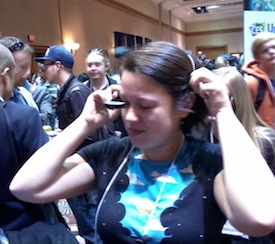
Wearable, but not quite a fashion accessory yet.
An augmented reality (AR) product showed promise at last week's CES. Vuzix was showing its boom-mounted smart phone display. It's not light enough yet to mount on a pair of regular eyeglasses, but with a dedicated headset it's comfortably wearable.
The video display is small, but it's always in front of you and at most requires a brief glance to read. Right now AR apps require you to hold a smart phone up in front of you to see a data overlay on reality – the names of streets, say, or product information in stores. The Vuzix headset lets you do that hands free.
Right now, its battery life is limited. It's just in the prototype stage, so tests haven't been completed, but the units on display at CES were said to last about three hours on one charge with everything running at once: video camera and WiFi, Bluetooth and GPS radios.
Even without a link to a smart phone it's pretty capable. Its TI OMAP 4 processor running Android 4.1 puts it in roughly the same class as a Samsung Galaxy 2, without the mobile telecoms capability.
It's expected to ship in the second half of this year at a price point in the $500 range. A software developer kit – an emulator application that runs on Windows – is available now.
The headset is just the first stop on the Vuzix AR roadmap. They have a mock-up of a pair of glasses that they hope to have working by CES next year. Similar to the Google Glass concept, it would provide a full field-of-view data AR overlay.
That's the point when AR starts to move from a novelty and, at best, occasional convenience to being a full time, commonplace tool. It'll take a while to develop to that point. Developers will need time with working units to come up with truly useful apps and then consumers will have to embrace that utility. But by CES 2015 or 16, you'll be able to see the world through data-enhanced eyes.
